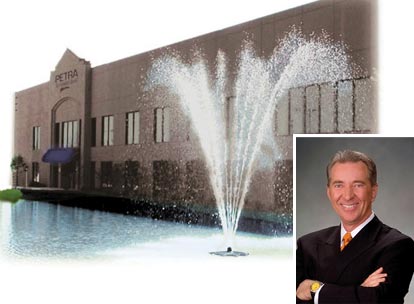
SEPTEMBER 2005
Oklahoma: An Editorial Survey (cover)
Once They Get Here
Textbook Case: Universities and the Telecom Cluster Are on the Same Page (sidebar)
Perception Is Not Reality
How Innovation Becomes Commercialization (sidebar)
Business Climate Brightens
Research Campus Key to City's Health Science Hub (sidebar)
Reporting for Duty; 'Coopetition' Is Key to Aviation Cluster Success (sidebar)
Oklahoma City Re-"MAPS" Its Future (sidebar)
Today's Forecast Calls for a New Industry Cluster (sidebar)
How Tulsa Is Funding a Metropolitan Makeover (sidebar)
Business Cost Advantage
Thank You, Texas
Distribution Center Locations Abound
CSI: Edmond (sidebar)
Making the Workforce Competitive
Wind Joins the
Energy Cluster
A New Day for Oil
and Gas
Pryor Claims Part of the NAFTA Corridor
Request Information

Business Climate Brightens

|
| Petra Industries distributes consumer electronics accessories and other products nationally from its base in Edmond, Oklahoma. Bill Stewart serves as president and CEO. |
And it's getting better. The state's business climate improved earlier this year with passage of workers' compensation reform legislation that will save Oklahoma businesses more than $100 million annually. Upon signing the measure into law on June 6th, Gov. Brad Henry noted, "This reform package will make Oklahoma's already positive business climate even more conducive to economic growth and job creation."
Oklahoma's aerospace industry became more competitive on July 1. That's when a new law went into effect exempting aerospace companies from collecting sales tax on parts used in maintenance and repair work. The measure eliminates a competitive disadvantage Oklahoma's aviation service companies had relative to other states, and it will help those companies grow their businesses and expand in some cases, creating more jobs.
Other measures signed into law in the most recent legislative session include a $100-million rebate to taxpayers, a reduction in the income tax rate, lower taxes for retirees and the elimination of the corporate capital gains tax on Oklahoma-held.

|
Business leaders around the state would like to see more progress on the workers' comp issue, but they also appreciate seeing the process under way. "Not everybody got what they wanted — that usually tells you they negotiated a reasonable deal," says Richels. "But it moved us a long way in putting a more realistic workers' compensation [plan] in place."
Says Kelly Owen, plant manager at Goodyear Tire's Lawton facility, "Frankly from a workers' comp cost perspective, we were very uncompetitive with other Goodyear locations in the U.S. The legislation that went through is very fair legislation; it takes care of our people, and it reduces costs."
With a payroll of 2,400 direct employees and 300 contract workers, any opportunity to reduce costs is taken seriously. The 26-year-old plant — the largest in Goodyear's property portfolio — is completing a $250-million modernization that was decided on well before the workers' comp legislation was passed. The plant had too much going for it in terms of labor and location to not proceed with the investment, says Owen. "We knew we had to either modernize the plant or start phasing it out," says Owen. "When Goodyear looked at the workforce here, the value we bring to the company and how much return this plant and this community have given to Goodyear over the years, investing here was a no-brainer."
The tire-manufacturing industry is highly competitive, with new plants coming online throughout the world and a steadily increasing flow of imported tires supplying the North American automotive industry. "To put $250 million in southwest Oklahoma is a big commitment, relative to investing in China or Latin America, where labor is much cheaper on a per-hour basis," notes Owen. The recent investment brings Goodyear's total investment in the facility to more than $720 million. A local 25-cent sales tax and a $36-million state incentives package helped fund the plant modernization.

|
| Kelly Owen, plant manager, Goodyear Tire & Rubber, Lawton |
The facility's Lawton location remains strategic to this day, with I-44 access south into the booming north Texas market and northeast to Oklahoma City and the various interstate highways there. "We have very good access to the ports on the Gulf of Mexico and the West Coast where we can ship our products all over the world," says Owen. "Our biggest market is North America, but we also ship to 18 countries." Easy access to the ports also benefits the plant on the front end, with rubber and other raw materials arriving from overseas.
Owen has worked at several Goodyear plants in three countries and swears by the quality of the labor in the Lawton area. "You cannot beat the work ethic in southwest Oklahoma. In terms of what we need as a manufacturing facility, we have good access to people, an excellent work ethic and a highly flexible workforce."
Adds Court Newkirk, economic development director at the Lawton Fort Sill Chamber of Commerce, "We have zero union representation at the manufacturing facilities in the City of Lawton."
Oklahoma became a right-to-work state in 2001.